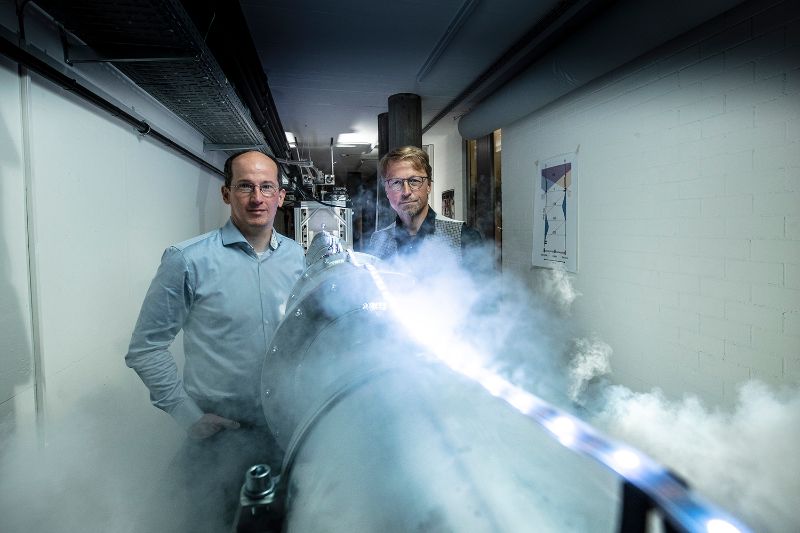Quantum leap in the quantum sciences
What does quantum physics have in common with engineering sciences? Not much at first glance. The former is more about seeking explanations for the purpose of understanding natural phenomena. The latter is more interested in practical applications. ETH Zurich shows that a combination holds the potential to produce new findings and applications. In the autumn of 2019, the novel Master’s degree programme in Quantum Engineering was launched and thanks to the “Quantum Center”, which was initiated shortly afterwards, the various quantum research-related activities can be made more interconnected and more visible. There are now a considerable number of professorships dealing with quantum physics and related technologies. In May 2021, the ETHZ-PSI Quantum Computing Hub was then founded for the development of quantum computers.
Two people are representative of the combination of engineering and quantum sciences at ETH Zurich and the expansion of the latter. Lukas Novotny, Professor at the Department of Information Technology and Electrical Engineering and Programme Director of the recently launched Master’s degree programme in Quantum Engineering, and Andreas Wallraff, Professor of Solid State Physics, founding director of the “Quantum Center” and Scientific Co-Head of the ETHZ-PSI Quantum Computing Hub. An engineer and a physicist. The fact that this concentrated expansion of quantum sciences is taking place at ETH Zurich is not an accident.
Threshold of possible applications
Quantum physics has already existed for over 100 years. Originally, it was a matter of understanding natural microscopic objects, such as atoms. It was first-generation physicists, such as Max Planck and Niels Bohr, who established quantum physics as a field of science. Later, there were applications that would not have been conceivable without quantum physics: transistors, lasers or magnetic resonance imaging (MRI) – the first quantum revolution. In the 1980s, theoretical ideas emerged of using quantum physics in information technology, for computers, communication or better sensors – something like the second quantum revolution. “ETH Zurich has always been strong in these areas, as well as in the foundations and applications of quantum physics,” is how Wallraff assesses the situation. “And now the combination of quantum physics with these fields is on the threshold of possible applications,” added Novotny.
In this spirit, the new Master’s degree programme in Quantum Engineering was the first of its kind to be developed. “We were aware that if we wanted to develop this field further towards application, the quantum scientists had to join the table of engineers,” says Novotny, “because the physicist always wants to understand why and how something is the way it is, but does not necessarily have a practical application in mind. The engineer always wants to know: What can I do with it?” At ETH Zurich, where quantum physics and engineering sciences are of great importance, this was the “golden moment” to add a new Master’s degree programme to the existing Bachelor programmes in both fields of study.
It only took a few months from the initial idea to students’ first rounds of applications – also because the Rectorate of ETH Zurich was well-disposed towards this project. The first graduates in Quantum Engineering will be in great demand. “I think 80 per cent will go into the private sector,” said Novotny. The reason is that new developments in devices must become more and more handy, faster and more sensitive. If we extrapolate this trend forwards, this means that the development will push the boundaries of what is possible today and “that is where quantum mechanics begins,” said Novotny.
It is likely that some time will pass before this results in a quantum leap which manifests itself in groundbreaking new applications. This is also evident where superconducting quantum computers are concerned, based on the way in which they are to be further developed at the ETHZ-PSI Quantum Computing Hub. These novel processors work differently than today’s computers, namely on the basis of so-called quantum bits (qubits). “Qubits expand the scope to do things that are not possible with conventional computers,” says Wallraff, “they push the limits of what is possible.” However, building quantum computers is a complex matter, as they often prove to be error-prone.
Quantum computer with 50 or perhaps even 100 qubits
Researchers at ETH Zurich are currently running quantum computers with up to 17 qubits. For the next development stage, an existing building was especially converted for research on quantum computers on the PSI premises due to the know-how available there on the planning and operation of large-scale facilities. The medium-term goal is to build a quantum computer with 50 or perhaps even 100 qubits. However, in order to exhaust the potential, thousands, if not hundreds of thousands of qubits are needed. Pie in the sky? “Nobody can estimate today what will be possible with quantum computers in the future. However, many companies and researchers are very optimistic,” said Wallraff, adding, “but above all, there are plenty of open scientific questions.”
